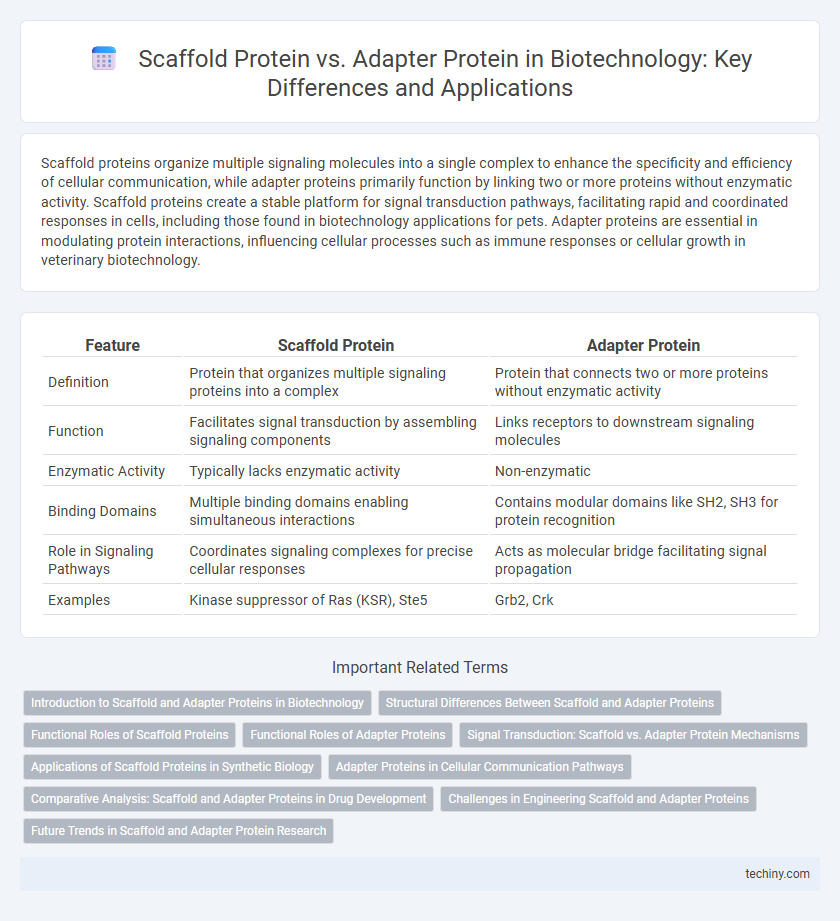Scaffold proteins organize multiple signaling molecules into a single complex to enhance the specificity and efficiency of cellular communication, while adapter proteins primarily function by linking two or more proteins without enzymatic activity. Scaffold proteins create a stable platform for signal transduction pathways, facilitating rapid and coordinated responses in cells, including those found in biotechnology applications for pets. Adapter proteins are essential in modulating protein interactions, influencing cellular processes such as immune responses or cellular growth in veterinary biotechnology.
Table of Comparison
| Feature | Scaffold Protein | Adapter Protein |
|---|---|---|
| Definition | Protein that organizes multiple signaling proteins into a complex | Protein that connects two or more proteins without enzymatic activity |
| Function | Facilitates signal transduction by assembling signaling components | Links receptors to downstream signaling molecules |
| Enzymatic Activity | Typically lacks enzymatic activity | Non-enzymatic |
| Binding Domains | Multiple binding domains enabling simultaneous interactions | Contains modular domains like SH2, SH3 for protein recognition |
| Role in Signaling Pathways | Coordinates signaling complexes for precise cellular responses | Acts as molecular bridge facilitating signal propagation |
| Examples | Kinase suppressor of Ras (KSR), Ste5 | Grb2, Crk |
Introduction to Scaffold and Adapter Proteins in Biotechnology
Scaffold proteins play a crucial role in biotechnology by organizing signaling components into specific complexes, enhancing signal transduction efficiency and specificity. Adapter proteins function as molecular connectors, facilitating interactions between distinct proteins without possessing intrinsic enzymatic activity. Both scaffold and adapter proteins are essential for manipulating cellular pathways in synthetic biology and therapeutic development.
Structural Differences Between Scaffold and Adapter Proteins
Scaffold proteins exhibit multiple binding domains that organize signaling complexes by physically co-localizing enzymes and substrates, enhancing specificity and efficiency. Adapter proteins typically contain fewer domains, often consisting mainly of small modular motifs such as SH2, SH3, or PH domains, facilitating transient protein-protein interactions without catalytic activity. The structural complexity of scaffold proteins allows stable multi-protein assemblies, whereas adapter proteins enable dynamic signal transduction through flexible and reversible interactions.
Functional Roles of Scaffold Proteins
Scaffold proteins play a crucial role in cellular signaling by organizing multiple enzymes into signaling complexes, thereby enhancing signal specificity and efficiency. Unlike adapter proteins that primarily facilitate protein-protein interactions, scaffold proteins provide a structural platform that spatially coordinates signaling molecules and modulates pathway dynamics. This organization prevents aberrant cross-talk and allows precise regulation of downstream biochemical responses critical for cell growth, differentiation, and apoptosis.
Functional Roles of Adapter Proteins
Adapter proteins play a critical role in cellular signaling by facilitating the formation of protein complexes, enabling the transmission of signals between receptors and downstream effectors without possessing intrinsic enzymatic activity. These proteins contain modular domains such as SH2, SH3, and PH domains, which allow them to bind specific phosphorylated tyrosines or proline-rich motifs, thus orchestrating signal transduction pathways. Unlike scaffold proteins that provide a platform for assembling multiple signaling components simultaneously, adapter proteins primarily mediate the specificity and regulation of signaling cascades through dynamic interactions.
Signal Transduction: Scaffold vs. Adapter Protein Mechanisms
Scaffold proteins organize multiple signaling components into a stable complex, enhancing signal specificity and efficiency by spatially coordinating kinases and substrates. Adapter proteins facilitate transient interactions by linking receptors to downstream effectors through modular domains like SH2 or SH3, enabling dynamic signal propagation. Both proteins are crucial for precise cellular responses in pathways such as MAPK and PI3K/Akt signaling cascades.
Applications of Scaffold Proteins in Synthetic Biology
Scaffold proteins play a crucial role in synthetic biology by organizing and stabilizing multi-enzyme complexes, enhancing metabolic pathway efficiency and specificity. These proteins facilitate precise spatial arrangement of enzymes, enabling improved signal transduction and metabolic flux control in engineered cells. Their application accelerates the development of biosensors, therapeutic pathways, and synthetic circuits, making them indispensable tools for metabolic engineering and synthetic biological systems.
Adapter Proteins in Cellular Communication Pathways
Adapter proteins play a critical role in cellular communication pathways by facilitating the assembly of signaling complexes without possessing intrinsic enzymatic activity. They contain multiple protein-binding domains that enable them to connect receptors or enzymes to downstream effectors, effectively transmitting extracellular signals into intracellular responses. This scaffolding function is essential for spatial and temporal regulation of signal transduction, impacting processes such as cell growth, differentiation, and immune responses.
Comparative Analysis: Scaffold and Adapter Proteins in Drug Development
Scaffold proteins organize multiple signaling molecules into complexes, enhancing signal specificity and efficiency, while adapter proteins facilitate transient interactions between signaling components without enzymatic activity. Scaffold proteins offer stable frameworks critical for drug targeting in pathways like MAPK/ERK, whereas adapter proteins modulate dynamic signaling networks, influencing cellular responses in cancer and immune therapies. Understanding their distinct structural roles and interaction modes enables development of precision drugs that selectively disrupt pathological signaling cascades.
Challenges in Engineering Scaffold and Adapter Proteins
Engineering scaffold and adapter proteins faces challenges including maintaining structural stability while enabling precise protein-protein interactions essential for signal transduction. Achieving specificity without cross-reactivity requires careful design of binding domains to avoid unintended interactions that can disrupt cellular pathways. Furthermore, optimizing expression levels and ensuring proper cellular localization complicate functional integration within complex biological systems.
Future Trends in Scaffold and Adapter Protein Research
Future trends in scaffold and adapter protein research emphasize the integration of advanced proteomics and computational modeling to map complex signaling networks with higher precision. Innovations in synthetic biology enable the design of customizable scaffold proteins to enhance targeted therapeutic pathways, improving treatment specificity. Enhanced understanding of adapter protein interactions will facilitate novel drug discovery approaches, particularly for diseases involving aberrant signal transduction.
Scaffold protein vs Adapter protein Infographic

 techiny.com
techiny.com